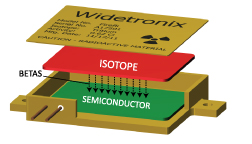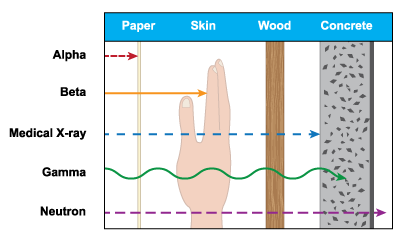
Technology
Widetronix’s betavoltaic power source is a small and efficient source for producing low power (nanowatts to microwatts) for flexible lifetimes (days to decades). Betavoltaic technology is over 50-years old and was developed for use in outerspace and medical implant applications. Widetronix has built upon the continued innovations in semiconductor materials to make an extremely energy-dense betavoltaic.
 There are three essential parts of a betavoltaic power source: the semiconductor, isotope and packaging. The semiconductor generates a DC current by harvesting high-energy beta particles emitted from an isotope source. The voltage is inherent to the choice of the semiconductor. In our case silicon carbide offers a very high open-circuit voltage. This solid state, physical energy conversion process, which parallels that of a photovoltaic (solar) cell, occurs efficiently, even in extreme environmental conditions.
There are three essential parts of a betavoltaic power source: the semiconductor, isotope and packaging. The semiconductor generates a DC current by harvesting high-energy beta particles emitted from an isotope source. The voltage is inherent to the choice of the semiconductor. In our case silicon carbide offers a very high open-circuit voltage. This solid state, physical energy conversion process, which parallels that of a photovoltaic (solar) cell, occurs efficiently, even in extreme environmental conditions.The isotope determines the current production of the device. By selecting the amount and type of isotope, a customized power source can be created with a specified output and lifetime. Power generated by a betavoltaic can be used immediately or stored for use later by a capacitor or thin-film battery.
The energy density of the device is dictated by the packaging. Advanced semiconductor packaging techniques can be used to create a small, safe, and reliable device.
Betavoltaics are often described as a battery, but they function in a very different fashion. Batteries and capacitors are energy storage devices; They use a variety of electrochemical or electrostatic reactions to store energy for one-time use or recharge. In contrast, betavoltaics continuously produce energy, which can be provided directly to a device or stored by a battery or capacitor.
Widetronix's betavoltaic power sources have a high-energy density with a ultra-low power output. This allows the betavoltaic device to have a lifespan that exceeds that of a capacitor or battery for low-power devices. This also allows it to operate effectively and function under extreme environmental conditions.
Safety Requirements

Safety is an inherent concern for any product containing radioactive material. Widetronix is committed to selling a safe, effective, and durable product to its customers.
The radioactive material used in our product emitts low-energy betas, which are stopped by a dead layer of skin. Standard semiconductor packaging is more than adequate to reduce any radiation levels to less than background reading.
There are over 5000 products containing radioactive material licensed for commercial sale by the Nuclear Regulatory Commission. Consumers interact with many of these products on a daily basis, including watches, smoke detectors and exit signs. To posses and work with Widetronix betavoltaics, specific licensing is required, for our customers to incorporate betavoltaics into their products. We have partnered with an independently-licensed, third-party organization to help our customers obtain these certificates.
Widetronix Innovation
Widetronix was originally spun out of Cornell University's Spencer Research Group as a start-up venture to commercialize wide bandgap semiconductor technology. These materials, such as silicon carbide, have inherent advantages to betavoltaics, including higher open circuit voltage (Voc=2.0V) and conversion efficiency (>20%), which improves power density and reduces cost. Improvements to the quality of silicon carbide wafers over the last decade, have been key drivers for commercializing betavoltaics using this material.
Another key market driver for betavoltaic markets is the improved energy efficiency of microcontrollers over the last decade. Companies such as Texas Instruments, MicroChip and Silicon Labs now have ultra low power chips with sleep currents in the 100's to 10's of nanoamps. This is the range of power where betavoltaics can be useful for providing chip-level power for lifetimes more than 25 years. While not appropriate for all applications, Widetronix has market traction with customers for applications in defense, medical and industrial sectors.
If you think that you have an application that might be well suited for betavoltaic technology or would like to learn more about our technology please contact us.
Home - About Us - Technology - Applications - Products - News - Contact - Video